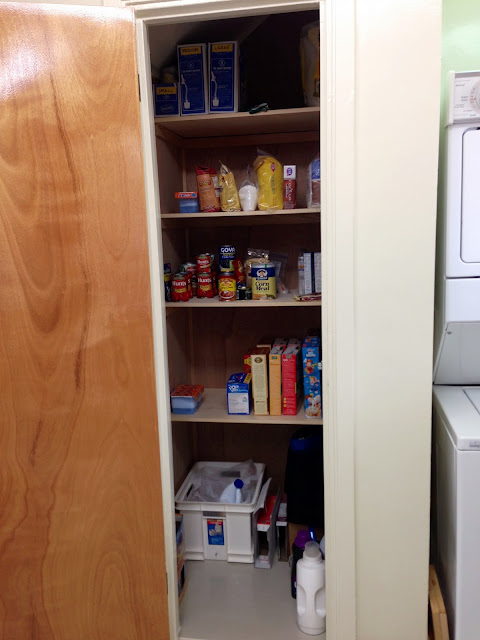The pantry is in decent shape, I don’t think I shared a photo. First let’s reminisce about the earlier “before” and “before-after” then I shall reveal the current “after”. The “before”-s were soon after we moved in with only minimal food on-hand, but it set the foundation for the advanced organization. Beginning with the top shelf we have: storage and plastic bags to reuse, dry goods, canned goods, cereals, and recycling and laundry detergents at floor level.
 |
| "before" |
Bonus: After searching a number of local stores I finally found a bright, battery-powered light that my husband installed in one minute with one little screw in the wall. Now we don't need to turn on a large light to see inside. This photo was taken while items were still being shifted around. (No, I didn't paint the trim green, its a bad cell phone photo).
 |
| "before-after" |
The current “after” follows in a similar fashion.
 |
| "after" |
Top shelf: Plastic bags to reuse, organized by size in the sturdy cardboard boxes that we buy our milk in, I use them all over the house (you’ll see). The back of the shelf holds less used items and the original boxes for a couple small, kitchen appliances including my beloved espresso machine. In the front are excess items we purchase in larger quantity, such as cat food and rice.
Second shelf: Pastas, rice, grains, and dry beans. I've been slowly acquiring plastic Snap-Ware containers for opened dry goods. Japan is made up of islands at the edge of an ocean and therefore is very humid. Add some heat and the possibility of mildew, mold, and insects increase. One of my sisters has been using the same Snap-Ware containers for years and likes them very much. They are air-tight, very stackable, and lightweight, which is important when you relocate frequently with a weight allowance. The under-shelf, wire bins are from IKEA, about $3.00 each. You’ll also see many white, wire shelves and organizers around our house, they are versatile beyond belief; I purchased most at thrift stores in the States for a dollar or two.
Third shelf: Canned goods. This is a challenging category. I love playing Tetris and have a pocket Game Boy dedicated to it; this shelf requires the same skills of stacking and rearranging to create the best use of space. They are roughly grouped and organized: various tomatoes, beans, ethnic, vegetables, soups, fruits, meat/seafood, cat food. On the right is more wire shelving; on the left is a different kind of metal shelving. It’s the common, chrome, wire shelving used commercially composed of various legs and shelves you can assemble to suit your needs. Daiso, a ¥100 store, carries small versions of them. The legs and shelf supports are ¥100 each but the shelves themselves are ¥300 each, making the unit I assembled about ¥800, or $8.00. They are more expensive than the plastic-coated wire shelves but are much more sturdy and can handle the weight of the cans better. You can see an example on Amazon here.
Fourth/Bottom shelf: Dry baking goods and cereals. This is self-explanatory. You’ll see more Snap-Ware. With the deep shelves we are able to keep the open cereal boxes in the front and the unopened behind. The roll of toilet paper is used for Kleenex.
Floor: Bigger, heavier items and laundry supplies. This area is still a bit messy because I’m still figuring out how to use it efficiently. On the right you’ll see our laundry supplies which must be kept there because the washer/dryer is directly next to the pantry and has no storage space of its own. The blue metal shelves are actually locker shelves (like this) I got on clearance for about $2.00 each – score! At a foot high, they are an awkward height to use in most places but are perfect for storing the large jugs in this tall space. There is another one directly behind it that fits perfectly over a box containing a large water jug and some MRE’s for an emergency food supply. On the left you’ll see kitty litter, cat food, paper towels, and other miscellaneous items. The cereal box is where we put out mixed paper recycling; it isn't picked up curbside so I drop it off at the recycling area when I’m out walking somewhere.
The finished pantry is not picture-perfect or magazine-worthy – the shelving doesn't match, everything isn't lined up symmetrically in baskets with pretty jars and cute labels, and there’s an open roll of toilet paper, for goodness’ sake – but it’s a real, working area that changes and conforms to current needs. And it’s mine, so put things back where you found them.
If you’re still reading, thank you. I can’t imagine my pantry is very exciting and I applaud your dedication. “Now what is that thing hanging off the door handle?” Since you asked, it’s a door stop. Well, my creative version of a door stop. We actually have screen doors at both the front and back of the house. I love them and like having them both open to encourage the lovely cross-breeze they create. However, the wind can blow the entry doors closed and, since Enterprise: The Best Kitty Ever is frequently there enjoying the view, it is very unsafe. Using the bungee on the door handles is the most secure idea I came up with and it was free.
(These photos were taken with an iPhone and are by no means intended to be "real" photos, just snapshots of where I was and what I saw.)

No comments:
Post a Comment